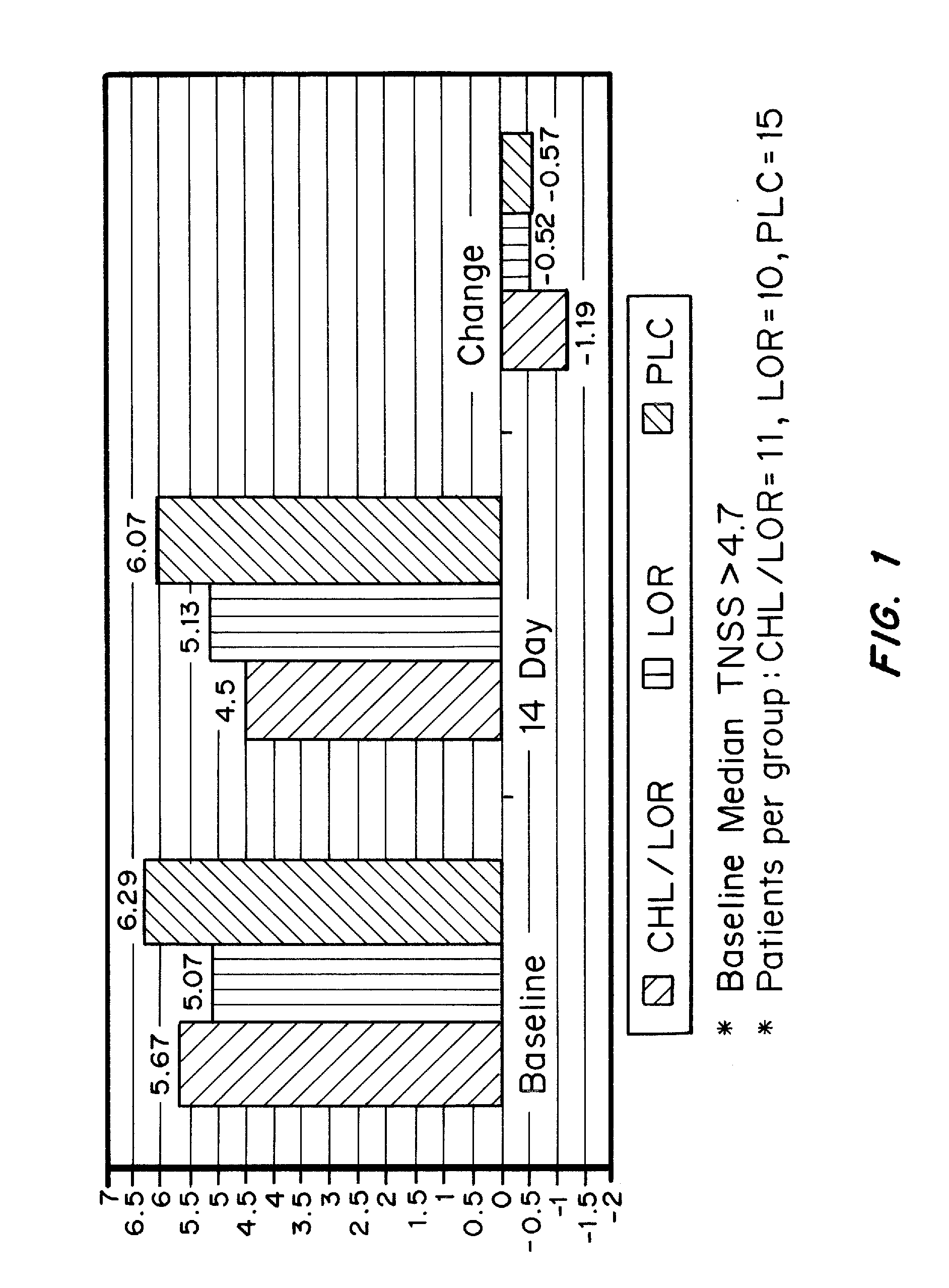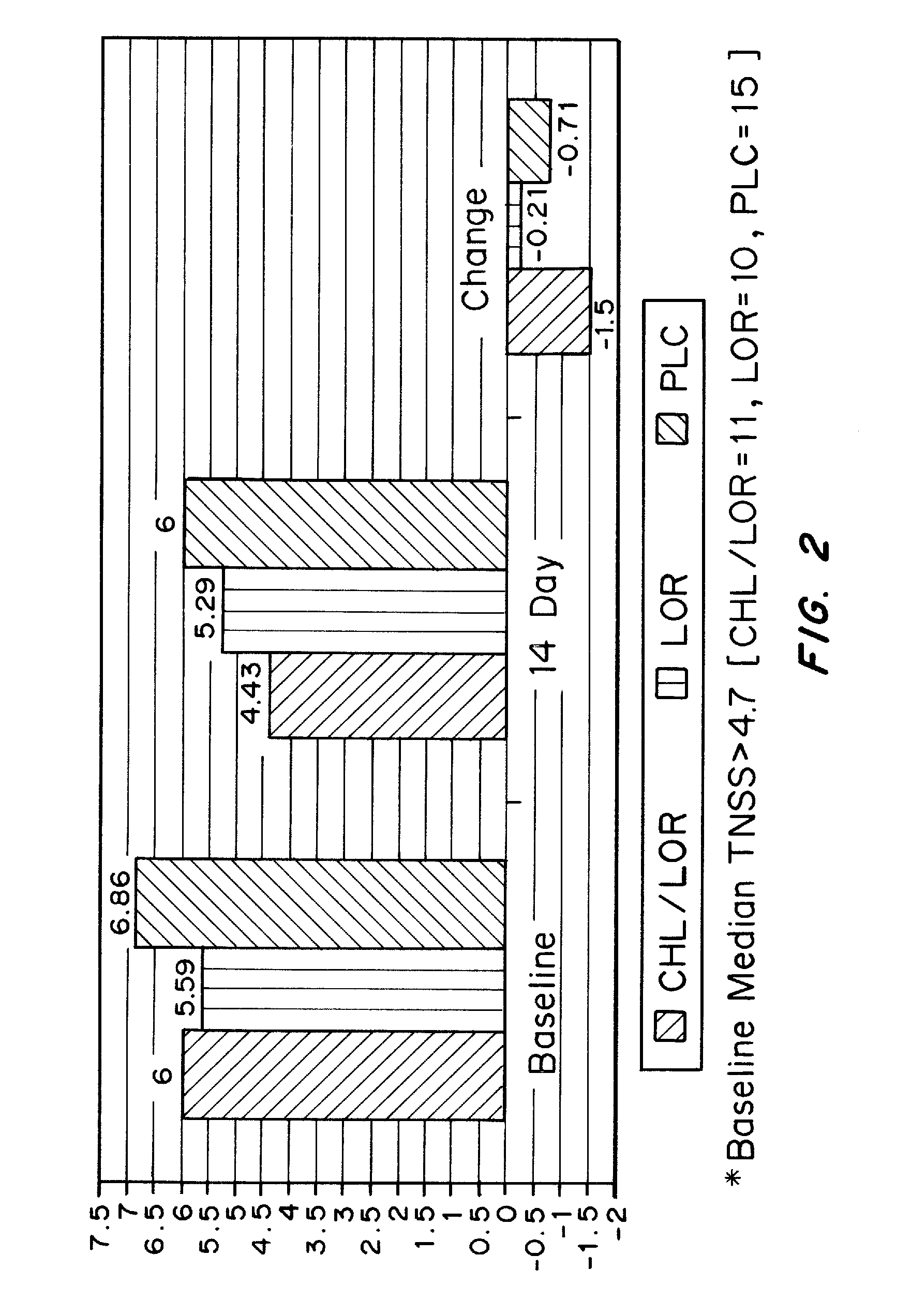Antihistamine Combination
a combination and antihistamine technology, applied in the direction of biocide, drug composition, immunological disorders, etc., can solve the problems of frequent symptoms, significant sleep abnormalities, direct and indirect costs of $5.3 billion per year, etc., and achieve the effect of relieving allergic symptoms
- Summary
- Abstract
- Description
- Claims
- Application Information
AI Technical Summary
Benefits of technology
Problems solved by technology
Method used
Image
Examples
example 1
Proof of Concept Clinical Study
1.1 Study Design
[0109]An open-label, placebo-controlled parallel-group comparison study was conducted. The protocol used was a 1 week run-in period, with daily placebo (PLC) for all groups, and a second 2 week period for treatment. Study participants were randomized to receive at bedtime (10 pm) during the treatment period, one of the following: PLC only; Immediate Release LOR 10 mg, or Immediate Release CHL 4 mg / Immediate Release LOR 10 mg. Commercially available IR tablets of CHL and LOR were packaged into capsules and used in this study. Participants filled out patient diaries in the morning (8 am) and evening (10 pm, prior to dosing). Reflective and Instantaneous TNSSs were recorded daily. Pittsburgh Sleep Quality Index (PSQI) was scored at the end of the study.
[0110]2.1 TNSS (Total Nasal Symptom Score)
[0111]Each symptom (rhinorrhea, nasal itching, sneezing) was scored on the following scale (Max Score=9):
[0112]0=absent symptoms (no sign / symptom ev...
example 2
Preparation of Immediate Release Loratadine Core Tablet
[0130]Loratadine USP (Micronized) from Morpen Labs (India) was used to manufacture immediate release (IR) Loratadine tablets. Particle size distribution of Loratadine, as determined using a Malvern Mastersizer 2000, was as following: 10% particles below 5 microns, 50% particles below 10 microns and 90% particles below 20 microns. All % particles are measured in % volume.
[0131]A wet granulation process was used for granulation. This process consisted of the steps of dry blending, wet granulation, drying, size reduction and final blending with extra-granular disintegrate and lubricant.
[0132]The first step of tablet granulation process was sifting Loratadine®, starch, lactose monohydrate and Avicel® PH101 (Microcrystalline cellulose) through 30 mesh sieve (600 μm). The second step consisted of dry blending of sifted material in a planetary mixer at low shear. In a separate container, polyvinyl pyrrolidone (Kollidon® 30) and sodium ...
example 3
Alternate Loratadine Core Tablet
[0135]In this example, tablets were made using a dry granulation method. The first step of tablet manufacturing process was sifting micronized Loratadine, lactose, Prosolv® 50, Ac-Di-Sol®, and SDS through 40 mesh sieve (425 micron). The second step consisted of dry mixing of sifted material in V-cone blender for 20 minutes. Aerosil® and Magnesium stearate sifted through 40 mesh sieve were then added and the resultant blend further mixed for 10 minutes. The final blend was compressed into tablets using 6 mm round standard concave punch at a hardness of 30-50 N.
TABLE 6Tablet composition for Loratadine IR tabletsAmount perIngredienttablet (mg)Loratadine USP10.00Lactose (Pharmatose DCL 14)29.14Prosolv 5029.14Ac-Di-Sol (5%)3.75SDS (2%)1.5Aerosil (1%)0.75Magnesium stearate (1%)0.75Tablet weight75.03
PUM
| Property | Measurement | Unit |
|---|---|---|
| pH | aaaaa | aaaaa |
| pH | aaaaa | aaaaa |
| pH | aaaaa | aaaaa |
Abstract
Description
Claims
Application Information
 Login to View More
Login to View More - R&D
- Intellectual Property
- Life Sciences
- Materials
- Tech Scout
- Unparalleled Data Quality
- Higher Quality Content
- 60% Fewer Hallucinations
Browse by: Latest US Patents, China's latest patents, Technical Efficacy Thesaurus, Application Domain, Technology Topic, Popular Technical Reports.
© 2025 PatSnap. All rights reserved.Legal|Privacy policy|Modern Slavery Act Transparency Statement|Sitemap|About US| Contact US: help@patsnap.com


